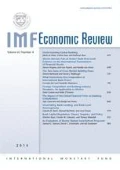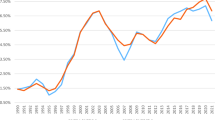Abstract
Most treatments of financial regulation worry about threats to the banking system and the economy from defaults or credit crunches. This paper argues that the recent crisis points to fire sales through capital markets as another source of financial and economic instability. Accounting for fire sales implies several changes to the standard approach. First, if there are three channels of instability, then three regulatory tools are needed to deliver stability. Second, if only a single capital tool and a single liquidity tool are available, then there is a risk that using them pushes activity into the shadow banking system. Third, liquidity requirements on the asset side of bank balance sheets are conceptually different from liquidity requirements on the liability side. The paper starts with a review of the recent theoretical work on fire sales that form the building blocks for a next generation of models of the financial system. A summary of some evidence suggesting that fire sales were present in the crisis is offered. Next, the paper outlines a general equilibrium framework that can be used to think about a financial system in which default, credit crunches, and fire sales are all possible. The paper concludes with a discussion of the regulatory options and some speculation on how such a framework could be extended.
Similar content being viewed by others
Notes
Similar assessments are offered by French and others (2010) and the U.S. Treasury (2009).
As they point out, if there is uncertainty about how long the bubble persists, the incentives to securitize become even more powerful because then the option to securitize at even higher prices comes into play.
Our existing model rule out the possibility of the bank simply raising enough capital to replace the capital lost as a result of the default. It is possible to complicate the model to allow this, but the structure of the model implies that as long as there are some rising marginal costs of raising outside equity, such as adverse selection, then banks will not immediately want to make up all the losses. Tsomocos (2003), working with a variant of this model, goes a step in this direction by allowing secondary market trading in equity after losses are realized. With rational expectations the secondary market prices are anticipated by the bank so it understands there is a risk of undercapitalization. Consequently we do not see this restriction as a problem.
There is a possible indirect effect whereby the bank holds more liquid assets but also securitizes more loans than it would otherwise, but in the numerical experiments we have considered this effect is inconsequential.
References
Adrian, Tobias, and Hyun Song Shin, 2010a, “Liquidity and Leverage,” Journal of Financial Intermediation, Vol. 19, No. 3 (July), pp. 418–437.
Adrian, Tobias, and Hyun Song Shin, 2010b, “Financial Intermediaries and Monetary Economics,” in Handbook of Monetary Economics 3A, ed. by Benjamin Friedman and Michael Woodford (Amsterdam, North Holland), pp. 601–650.
Brière, Marie, and Ombretta Signori, 2009, “Do Inflation-Linked Bonds Still Diversify?” European Financial Management, Vol. 15, No. 2, pp. 279–297.
Brunnermeier, Markus, and Lasse H. Pedersen, 2009, “Deciphering the Liquidity and Funding Liquidity,” Review of Financial Studies, Vol. 22, No. 6, pp. 2201–2238.
Campbell, John Y., Robert J . Shiller, and Luis M. Viceira, 2009, “Understanding Inflation-Indexed Bond Markets,” Brooking's Papers on Economics Activity (Spring 2009), pp. 79–120.
Christiano, Lawrence J., Roberto Motto, and Massimo Rostagno, 2010, “Financial Factors in Economic Fluctuations,” ECB Working Paper Series, No. 1192, May.
Curdia, Vasco, and Michael Woodford, 2009, “Credit Frictions and Optimal Monetary Policy,” NBER Working Paper No. 15289.
Diamond, Douglas W., and Raghuram Rajan, 2011, “Fear of Fire Sales and the Credit Freeze,” Quarterly Journal of Economics, forthcoming.
Duffie, Darrell, 2010, “Presidential Address: Asset Price Dynamics with Slow-Moving Capital,” The Journal of Finance, Vol. LXV, No. 4, pp. 1237–1267.
French, Kenneth R., and others, 2010, The Squam Lake Report (Princeton, NJ, Princeton University Press).
Geanakoplos, John, 1997, “Promises, Promises,” in The Economy as an Evolving Complex System, II, ed. by W. Brian Arthur, Steven N. Durlauf, and David A. Lane (Reading, MA, Addison-Wesley), pp. 285–320.
Geanakoplos, John, 2003, “Liquidity, Default, and Crashes: Endogenous Contracts in General Equilibrium,” in Advances in Economics and Econometrics: Theory and Applications, Eighth World Congress, Vol. II, Econometric Society Monographs, editors, ed. by Mathias Dewatripont, Lars Peter Hansen, and Stephen J. Turnovsky (Cambridge, Cambridge University Press), pp. 170–205.
Geanakoplos, John, 2009, “The leverage cycle,” in NBER Macroeconomics Annual 2009, Vol. 24, ed. by Daron Acemoglu, Kenneth Rogoff, and Michael Woodford (Cambridge, MA, MIT Press), pp. 1–65.
Gertler, Mark, and Nobuhiro Kiyotaki, 2010, “Financial Intermediation and Credit Policy in Business Cycle Analysis,” in Handbook of Monetary Economics, Vol. 3A, ed. By Benjamin M. Friedman and Michael Woodford (Amsterdam, North-Holland), pp. 547–599.
Gertler, Mark, and Peter Karadi, 2011, “A Model of Unconventional Monetary Policy,” Journal of Monetary Economics, Vol. 58, No. 1 (January), pp. 17–34.
Goodhart, Charles A.E., Carolina Osorio, and Dimitrios P. Tsomocos, 2010, “The Optimal Monetary Policy Instrument, Inflation versus Asset Price Targeting, and Financial Stability,” in Inflation Targeting Twenty Years On, ed. by David Cobham, Øyvind Eitrheim, and Stefan Gerlach (Cambridge, Cambridge University Press, Norges Bank).
Goodhart, Charles A.E., Dimitrios P. Tsomocos, and Alexandros P. Vardoulakis, 2010, “Modelling a Housing and Mortgage Crisis,” in Financial Stability, Monetary Policy and Central Banking. Series in on Central Banking, Analysis and Economic Policies. ed. by C. Echeverria, R. Fuentes, and D. Gray (Central Bank of Chile).
Gorton, Gary, and Andrew Metrick, 2010, “Securitized Banking and the Run on Repo,” Yale University Working Paper.
Griffoli, Tommaso Mancini, and Angelo Ranaldo, 2010, “Limits to Arbitrage During the Crisis: Funding Liquidity Constraints and Covered Interest Parity,” Working Paper Swiss National Bank 2010-14.
Gromb, Dennis, and Dimitri Vayanos, 2002, “Equilibrium and Welfare in Markets with Financially Constrained Arbitrageurs,” Journal of Financial Economics, Vol. 66, No. 2–3, pp. 361–407.
Hanson, Samuel, Anil Kashyap, and Jeremy Stein, 2011, “A Macroprudential Approach to Financial Regulation,” Journal of Economic Perspectives, Vol. 25, No. 1 (winter) pp. 3–28.
Mitchell, Mark, and Todd Pulvino, 2010, “Arbitrage Crashes and the Speed of Capital,” Working Paper.
Shleifer, Andrei, and Robert Vishny, 2010, “Unstable Banking,” Journal of Financial Economics, Vol. 97, No. 3, pp. 303–318.
Shleifer, Andrei, and Robert Vishny, 2011, “Fire Sales in Finance and Macroeconomics,” Journal of Economic Perspectives, Vol. 25, No. 1, (winter) pp. 29–48.
Shubik, Martin, 1973, “Commodity Money, Oligopoly, Credit and Bankruptcy in a General Equilibrium Model,” Western Economic Journal, Vol. 11, No. 1, pp. 24–38.
Tsomocos, Dimitrios P., 2003, “Equilibrium Analysis, Banking, and Financial Instability,” Journal of Mathematical Economics, Vol. 39, No. 5–6 (July) pp. 619–655.
US Treasury, 2009, Financial Regulatory Reform: A New Foundation. Available from the Internet: www.treasury.gov/initiatives/wsr/Documents/FinalReport_eb.pdf.
Wright, Jonathan, 2009, “Comment on John Y. Campbell, Robert J. Schiller, Luis M. Viceira,” Brooking's Papers on Economics Activity (spring), pp. 126–135.
Additional information
*Anil K Kashyap is a professor at the University of Chicago Booth School of Business, a research associate at the National Bureau of Economic Research and a consultant at the Federal Reserve Bank of Chicago. Berner was co-head of Global Economics at Morgan Stanley at the time the article was written. Charles A.E. Goodhart is a professor emeritus at the London School of Economics. Prepared for the Mundell-Fleming Lecture for International Monetary Fund Annual Research Conference. The authors thank Douglas Diamond, Martin Hegarty, Carolina Osorio, Jeremy Stein, Michael Pond, Dimitrios Tsomocos, Alex Vardoulakis, Rob Vishny, and Mihir Worah for helpful conversations. Kashyap thanks the Initiative on Global Market and the Center for Research on Securities Prices at Chicago Booth for research support. The views expressed are those of the authors alone and not necessarily those of the institutions with which they are affiliated. All errors are the authors’ own.




